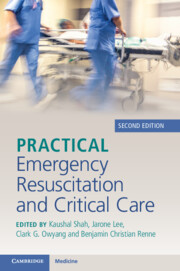Book contents
- Practical Emergency Resuscitation and Critical Care
- Practical Emergency Resuscitation and Critical Care
- Copyright page
- Contents
- Contributors
- Preface
- Section 1 General Critical Care
- Section 2 Infectious Disease Emergencies
- Section 3 Neurological Emergencies
- Section 4 Cardiovascular Emergencies
- 16 Post-Cardiac Arrest Care
- 17 Acute Coronary Syndrome
- 18 Acute Decompensated Heart Failure
- 19 Aortic Dissection
- 20 Hypertensive Emergencies
- 21 Valvular Diseases
- Section 5 Respiratory Emergencies
- Section 6 Gastrointestinal Emergencies
- Section 7 Renal Emergencies
- Section 8 Hematology–Oncology Emergencies
- Section 9 Endocrine Emergencies
- Section 10 Environmental Emergencies
- Section 11 Trauma
- Section 12 End of Life
- Index
- References
18 - Acute Decompensated Heart Failure
from Section 4 - Cardiovascular Emergencies
Published online by Cambridge University Press: 02 November 2023
- Practical Emergency Resuscitation and Critical Care
- Practical Emergency Resuscitation and Critical Care
- Copyright page
- Contents
- Contributors
- Preface
- Section 1 General Critical Care
- Section 2 Infectious Disease Emergencies
- Section 3 Neurological Emergencies
- Section 4 Cardiovascular Emergencies
- 16 Post-Cardiac Arrest Care
- 17 Acute Coronary Syndrome
- 18 Acute Decompensated Heart Failure
- 19 Aortic Dissection
- 20 Hypertensive Emergencies
- 21 Valvular Diseases
- Section 5 Respiratory Emergencies
- Section 6 Gastrointestinal Emergencies
- Section 7 Renal Emergencies
- Section 8 Hematology–Oncology Emergencies
- Section 9 Endocrine Emergencies
- Section 10 Environmental Emergencies
- Section 11 Trauma
- Section 12 End of Life
- Index
- References
Summary
Heart failure (HF) is a clinical syndrome marked by elevated filling pressures to maintain acceptable cardiac output. Current guidelines use left ventricular ejection fraction (LVEF) to distinguish between reduced (HFrEF; LVEF < 40%), preserved (HFpEF; LVEF > 50%) and midrange ejection fractions (HFmrEF; LVEF between 40–49%).
Beta blockers, angiotensin-converting enzyme (ACE) inhibitors, angiotensin receptor neprilysin inhibitors (ARNI), sodium-glucose transporter-2 (SGLT2) inhibitors and cardiac resynchronization therapy, among other therapies, improve outcomes in HFrEF. HFpEF management focuses on comorbidity management with recent data showing benefit from SGLT-2 inhibitor, empagliflozin.
Keywords
- Type
- Chapter
- Information
- Practical Emergency Resuscitation and Critical Care , pp. 159 - 168Publisher: Cambridge University PressPrint publication year: 2023

